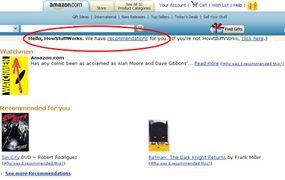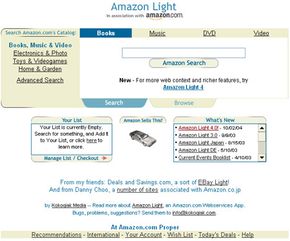
In 1995, Amazon.com sold its first book, which shipped from Jeff Bezos' garage in Seattle. In 2006, Amazon.com sells a lot more than books and has sites serving seven countries, with 21 fulfillment centers around the globe totaling more than 9 million square feet of warehouse space.
The story is an e-commerce dream, and Jeff Bezos was Time magazine's Person of the Year in 1999. The innovation and business savvy that sustains Amazon.com is legendary and, at times, controversial: The company owns dozens of patents on e-commerce processes that some argue should remain in the public domain. In this article, we'll find out what Amazon does, what makes it different from other e-commerce Web sites and how its technology infrastructure supports its multi-pronged approach to online sales.
Advertisement
Amazon.com Basics
Amazon.com sells lots and lots of stuff. The direct Amazon-to-buyer sales approach is really no different from what happens at most other large, online retailers except for its range of products. You can find beauty supplies, clothing, jewelry, gourmet food, sporting goods, pet supplies, books, CDs, DVDs, computers, furniture, toys, garden supplies, bedding and almost anything else you might want to buy. What makes Amazon a giant is in the details. Besides its tremendous product range, Amazon makes every possible attempt to customize the buyer experience.
When you arrive at the homepage, you'll find not only special offers and featured products, but if you've been to Amazon.com before, you'll also find some recommendations just for you. Amazon knows you by name and tries to be your personal shopper.

The embedded marketing techniques that Amazon employs to personalize your experience are probably the best example of the company's overall approach to sales: Know your customer very, very well. Customer tracking is an Amazon stronghold. If you let the Web site stick a cookie on your hard drive, you'll find yourself on the receiving end of all sorts of useful features that make your shopping experience pretty cool, like recommendations based on past purchases and lists of reviews and guides written by users who purchased the products you're looking at.
The other main feature that puts Amazon.com on another level is the multi-leveled e-commerce strategy it employs. Amazon.com lets almost anyone sell almost anything using its platform. You can find straight sales of merchandise sold directly by Amazon, like the books it sold back in the mid-'90s out of Jeff Bezos' garage -- only now they're shipped from a very big warehouse. Since 2000, you can also find goods listed by third-party sellers -- individuals, small companies and retailers like Target and Toys 'R Us. You can find used goods, refurbished goods and auctions. You could say that Amazon is simply the ultimate hub for selling merchandise on the Web, except that the company has recently added a more extroverted angle to its strategy.
In addition to the affiliate program that lets anybody post Amazon links earn a commission on click-through sales, there's now a program that lets those affiliates (Amazon calls them "associates") build entire Web sites based on Amazon's platform. They can literally create mini Amazon Web sites if they want to, building on Amazon's huge database of products and applications for their own purposes. As long as any purchases go through Amazon, you can build a site called Amazonish.com, pull products directly from Amazon's servers, write your own guides and recommendations and earn a cut of any sales. Amazon has become a software developer's playground.
Before we dig deeper into Amazon's e-commerce methods, let's take a quick look at the technology infrastructure that makes the whole thing possible.
Advertisement





